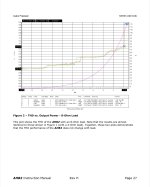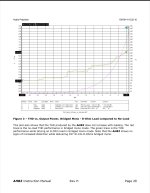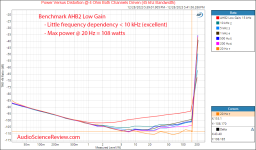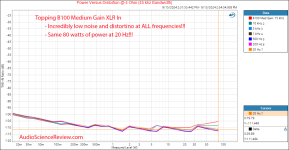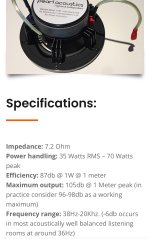BTL configuration usually promoted for higher power but what is lesser known is the reduced overall distortion and noise cancellation due to the balanced output. Possibly this also helps the B100 with the impressive SINAD …
I took this photo 1 month ago in Hanzhong China:Look at their cities ! US is "ghetto" compared to the typical modern 22'nd century "star trek" Chinese city.
They have their own space station , and don't have to leave astronauts stranded there.
OS
Between Hanzhong (population 3M) and Xi’an (population 12M) I saw literally 100 buildings like this. 1/3 finished, probably will never be completed. Devastating real estate crash. Epic levels of corruption and fraud. This problem extends all over the country with many “ghost cities.” With population levels in free fall.
To your point, I also saw gorgeous parks and walking malls. It’s not all disaster. The Huawei store at a mall had amazing vehicles, watches and phones, as though Apple and Tesla had a baby.
But China has some very very serious economic problems.
Along with possible precision internal device matching the most interesting unknown about this amp. The extent to which these - in my view trivial - operational compromises were driven by performance optimisation.what is lesser known is the reduced overall distortion and noise cancellation
e.g. For the AHB2 amp, can be bridged also. Apart from increased power, the distortion figures are even better - most likely because of the balanced action at the load itself:
Attachments
Last edited:
A bridged output Amp sees a floating load so the effective load for each Amp is doubled and so the current drive accordingly. So a nominal 8 ohm speaker load will look like 4 ohm to each Amp. The B100 specs puts 4 ohm load limit so will be easy to trip if ever the load impedance goes below that. Maybe this is the reason why some speakers are not suitable for B100?
Is a Topping really better than a Benchmark ABH2?
IMD -20dB lower on the Topping B200, crosstalk zero if using monoblocs than using a single AHB2.
https://www.audiosciencereview.com/...er-low-gain-multitone-measurement-png.337826/
https://cdn.prod.website-files.com/...6_668b904180ec750137b5eb11_B200%20-en-13.jpeg
https://www.audiosciencereview.com/...er-low-gain-crosstalk-measurement-png.337828/
I have both, B200 for 5 days.
Yamaha AS2000.>Hypex NC400>Neurochrome Mod 86 bridged>Benchmark AHB2>Topping B200.
All through Topping Pre90 into fully tricked Quad 989 ESL's.
My question was rhetorical. A topping B200 is not better than a Benchmark ABH2 because it cannot drive a real-world load without tripping out. I respectfully suggest that the Topping B200 is an overblown headphone amp.
We started a discussion on the forum about a year ago about coming up with a way to weight amplifier performance precisely because of the fixation on ppm distortion at the expense of everything else and the Topping B200 is a case in point. It has clearly been designed to game Amir's 5W SINAD test. Take a look at the dozens of loudspeaker tests done by John Atkinson over the years at Stereophile. He always includes an impedance and phase plot. Many speakers dip below 4 ohms in the critical 100-800 Hz region, just where you have the most music energy and a lot dip below 3 ohms. The Topping won't drive those loads at concert hall levels. The ABH2 will.
I abandoned the amplifier weighting idea precisely because many people refused to see that a good amplifier is the sum of its parts, not just ppm distortion.
We started a discussion on the forum about a year ago about coming up with a way to weight amplifier performance precisely because of the fixation on ppm distortion at the expense of everything else and the Topping B200 is a case in point. It has clearly been designed to game Amir's 5W SINAD test. Take a look at the dozens of loudspeaker tests done by John Atkinson over the years at Stereophile. He always includes an impedance and phase plot. Many speakers dip below 4 ohms in the critical 100-800 Hz region, just where you have the most music energy and a lot dip below 3 ohms. The Topping won't drive those loads at concert hall levels. The ABH2 will.
I abandoned the amplifier weighting idea precisely because many people refused to see that a good amplifier is the sum of its parts, not just ppm distortion.
Not clear here. Across the spectrum and at all power levels of relevance to many users the Topping handily tops the Benchmark in maintaining extremely low distortion across the entire spectrum with no evidence of level-dependent modulation. For owners of speakers with moderate loads and power limits with no desire to 'rock the block' the Benchmark's engineering advantages shift to overall reliability, aesthetics and support.It has clearly been designed to game Amir's 5W SINAD test.
Attachments
For a two minute wonder at most?Across the spectrum and at all power levels of relevance to many users the Topping handily tops the Benchmark in maintaining extremely low distortion across the entire spectrum with no evidence of level-dependent modulation.
How does it perform driving a real-world load at concert hall levels? Again, see the Stereophile amplifier tests at 8 ohms, 4 ohms and 2 ohm tests and then into a simulated speaker load. That at a minimum is what I'd expect an amplifier that is going out into the mass market to be able to cater to. I don't expect an amplifier to drive 2 ohms continuously (I do 2 minutes), but it should handle impedance dips gracefully.Not clear here. Across the spectrum and at all power levels of relevance to many users the Topping handily tops the Benchmark in maintaining extremely low distortion across the entire spectrum with no evidence of level-dependent modulation. For owners of speakers with moderate loads and power limits with no desire to 'rock the block' the Benchmark's engineering advantages shift to overall reliability, aesthetics and support.
How does it perform driving a real-world load at concert hall levels?
As a value judgement that's an inarguable position but 2 ohms at concert hall levels has always been irrelevant in my living room. As it appears true of many. Working down today's first page of Stereophile bookshelf reviews, the minimum impedance is:
PS AUdio Aspen 5 : 5.6 ohms
Quad Revela 1 : 4.1 ohms
B&W 805 D4 Sig : 4.6 ohms
Franco Serblin Accordo Goldberg : 3.8 ohms
McIntosh ML1 MkII : 3.77 ohms
Wharfedale Heritage Series 90th Anniversary Dovedale : 3.6 ohms
Thrax Audio Siren : 4 ohms
DeVore Fidelity Orangutan O/baby : 7.1 ohms
It makes little sense to reject a single figure of merit like SINAD, which I agree is essentially useless, and replace it with a single must-have metric like 2 ohm current drive. The optimum engineering solution is always a circumstantial balance.
Check the threads. PMA, after some hurdles caused by driving the balanced inputs with an unbalance signal, used more steady state tones.those tests by ASR
BTW I think ASR's were even shorter than 2 seconds.
SINAD is a useful figure of merit but we also need to consider real world use cases where reports of B100 shutting down even before reaching acceptable listening levels. Of course there are some interesting workarounds to enjoy the spectacular low distortion performance. I found this case interesting where a helper sub is used:It makes little sense to reject a single figure of merit like SINAD, which I agree is essentially useless, and replace it with a single must-have metric like 2 ohm current drive. The optimum engineering solution is always a circumstantial balance.
https://forum.audiogon.com/discussions/topping-b100-brief-impressions
phase angle?As a value judgement that's an inarguable position but 2 ohms at concert hall levels has always been irrelevant in my living room. As it appears true of many. Working down today's first page of Stereophile bookshelf reviews, the minimum impedance is:
PS AUdio Aspen 5 : 5.6 ohms
Quad Revela 1 : 4.1 ohms
B&W 805 D4 Sig : 4.6 ohms
Franco Serblin Accordo Goldberg : 3.8 ohms
McIntosh ML1 MkII : 3.77 ohms
Wharfedale Heritage Series 90th Anniversary Dovedale : 3.6 ohms
Thrax Audio Siren : 4 ohms
DeVore Fidelity Orangutan O/baby : 7.1 ohms
It makes little sense to reject a single figure of merit like SINAD, which I agree is essentially useless, and replace it with a single must-have metric like 2 ohm current drive. The optimum engineering solution is always a circumstantial balance.
I don't think 2 ohm drive capability should replace SINAD and I didn't suggest one should replace the other - you are selectively misinterpreting my position. This exchange we are having simply serves to highlight the futility of using distortion performance as the sole measure of amplifier performance. On the B200, we don't know how it recovers when overdriven, its response into a complex load, slew rate performance etc. However, we do know it shuts down if presented with anything much less than 4 ohms.As a value judgement that's an inarguable position but 2 ohms at concert hall levels has always been irrelevant in my living room. As it appears true of many. Working down today's first page of Stereophile bookshelf reviews, the minimum impedance is:
PS AUdio Aspen 5 : 5.6 ohms
Quad Revela 1 : 4.1 ohms
B&W 805 D4 Sig : 4.6 ohms
Franco Serblin Accordo Goldberg : 3.8 ohms
McIntosh ML1 MkII : 3.77 ohms
Wharfedale Heritage Series 90th Anniversary Dovedale : 3.6 ohms
Thrax Audio Siren : 4 ohms
DeVore Fidelity Orangutan O/baby : 7.1 ohms
It makes little sense to reject a single figure of merit like SINAD, which I agree is essentially useless, and replace it with a single must-have metric like 2 ohm current drive. The optimum engineering solution is always a circumstantial balance.
You stated that the B200 'handily beats' the ABH2 on distortion at relevant power levels'. I have a headphone amp that does about 100 ppb into 60 ohms. Into relevant power levels I reckon it will handily beat the B200 (without shutting down).
Here is a snip from the Stereophile PS audio Aspen review (the first speaker on your list) - EPDR is the important spec because you have to consider phase angle as well as load impedance:-
Some of the bookshelf speakers you mentioned have horrendous sensitivity specs - the PS Audio Aspen was measured at 82.3 dB - for a 100W amp at 2 metres that's 102 dB SPL.
Last edited:
I have got the Sibelius speakers here driven by AHB2. No helper sub needed as the bass extension of the speakers are reasonably good. Impedance ok. An interesting test by Harley, very convincing to try out with the B100s:
Attachments
Apologies B100.
Also, the 102dB figure I quoted was for 2m not 1m because that is deemed a reasonably close spprox to a normal small room listening position. The 102 dB figure is for a 100W amp. On single tones, 1W will sound loud, but on multiple tones not so much eg 1W power from a white noise source vs 1 W from a single tone.
Also, the 102dB figure I quoted was for 2m not 1m because that is deemed a reasonably close spprox to a normal small room listening position. The 102 dB figure is for a 100W amp. On single tones, 1W will sound loud, but on multiple tones not so much eg 1W power from a white noise source vs 1 W from a single tone.
- Home
- Amplifiers
- Solid State
- Topping B100
